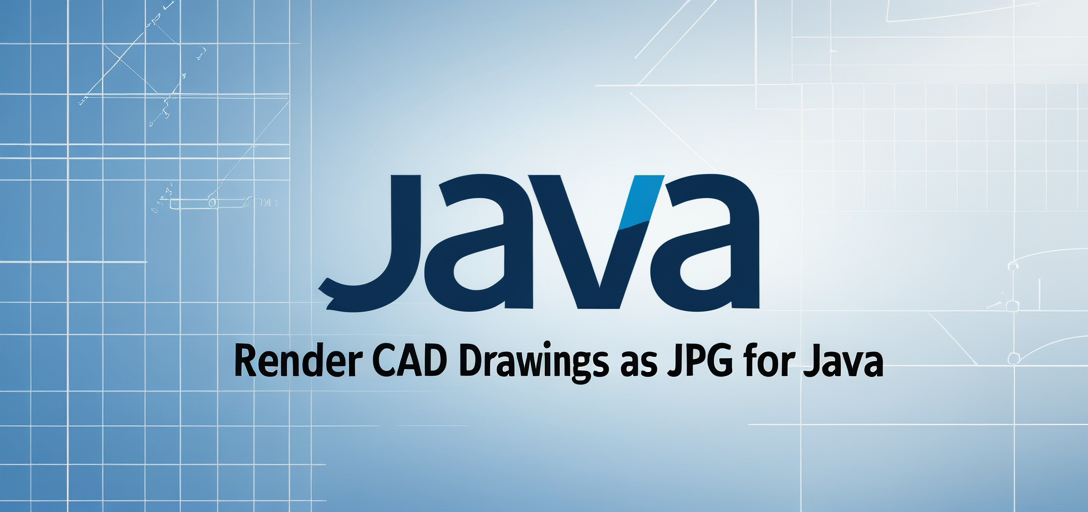How to Render CAD Drawings as JPGs Using GroupDocs.Viewer Java: A Step-by-Step Tutorial
Introduction
Converting intricate Computer-Aided Design (CAD) drawings from DWG format into more accessible JPG images can be challenging. This comprehensive guide will demonstrate how to utilize GroupDocs.Viewer for Java to render CAD drawings with specific configurations using a PC3 configuration file.

What You’ll Learn:
- Setting up your environment for GroupDocs.Viewer
- Configuring paths for rendering output
- Implementing the feature to render DWG files as JPGs with specific settings
Let’s dive in and transform your CAD drawings effortlessly!
Prerequisites
Before we begin, ensure you have the following:
Required Libraries and Dependencies
- GroupDocs.Viewer for Java: Use version 25.2 of this library.
Environment Setup Requirements
- Set up your development environment with Java (preferably JDK 8 or above).
Knowledge Prerequisites
- Basic understanding of Java programming
- Familiarity with handling file paths and directories in Java
Setting Up GroupDocs.Viewer for Java
To start, include the necessary dependencies. If you’re using Maven, add this configuration:
<repositories>
<repository>
<id>repository.groupdocs.com</id>
<name>GroupDocs Repository</name>
<url>https://releases.groupdocs.com/viewer/java/</url>
</repository>
</repositories>
<dependencies>
<dependency>
<groupId>com.groupdocs</groupId>
<artifactId>groupdocs-viewer</artifactId>
<version>25.2</version>
</dependency>
</dependencies>
License Acquisition
- Free Trial: Download a trial version from GroupDocs Free Trial.
- Temporary License: Obtain a temporary license for full-feature access at GroupDocs Temporary License.
- Purchase: For long-term use, purchase a license through GroupDocs Purchase.
Basic Initialization
After setting up your environment and adding dependencies, initialize GroupDocs.Viewer in your Java application:
import com.groupdocs.viewer.Viewer;
public class ViewerInitialization {
public static void main(String[] args) {
try (Viewer viewer = new Viewer("path/to/your/dwg/file.dwg")) {
// Your rendering code will go here.
}
}
}
Implementation Guide
Rendering CAD Drawings with Specific Configuration
This feature allows you to render a DWG file into a JPG image using specific configurations defined in a PC3 file.
Overview
We’ll load the DWG drawing and set up rendering options using GroupDocs.Viewer’s JpgViewOptions. The PC3 configuration will determine the size and layout of the output image.
Step-by-Step Implementation
Import Required Packages
Ensure these imports are in your Java file:
import com.groupdocs.viewer.Viewer;
import com.groupdocs.viewer.options.JpgViewOptions;
import java.nio.file.Path;
import java.nio.file.Paths;
Define Output Directory and File Path
Set up the output directory for the rendered image:
Path outputDirectory = Paths.get("YOUR_OUTPUT_DIRECTORY");
Path pageFilePathFormat = outputDirectory.resolve("pc3_result.jpg");
Load CAD Drawing and Set Configuration
Use Viewer to load your DWG file and configure it with a PC3 file:
try (Viewer viewer = new Viewer(TestFiles.SAMPLE_DWG_WITH_LAYOUTS_AND_LAYERS)) {
JpgViewOptions options = new JpgViewOptions(pageFilePathFormat);
// Set the PC3 configuration for rendering
options.getCadOptions().setPc3File(TestFiles.SAMPLE_PC3_CONFIG);
// Render the CAD drawing to a JPG image
viewer.view(options);
}
Troubleshooting Tips
- Missing Dependencies: Ensure all necessary libraries are included in your project.
- Incorrect Paths: Double-check file paths and directories for accuracy.
Path Configuration for Rendering Output
This section guides you on setting up paths for rendering outputs in a specific directory structure.
Overview
Proper path configuration is essential for organizing rendered files efficiently.
Define Output Directory Path
Set the output directory using a placeholder:
Path outputDirectory = Paths.get("YOUR_OUTPUT_DIRECTORY");
Construct File Path for Rendered Image
Create a file path with a naming format:
Path pageFilePathFormat = outputDirectory.resolve("pc3_result.jpg");
Practical Applications
Here are some real-world use cases where this feature can be beneficial:
- Architectural Design: Convert CAD drawings of buildings into JPGs for easy sharing.
- Engineering Projects: Render complex engineering designs for presentations.
- Interior Design: Share layout plans with clients in a more accessible format.
Performance Considerations
To ensure optimal performance when using GroupDocs.Viewer:
- Optimize Resource Usage: Close
Viewerobjects promptly to free resources. - Java Memory Management: Monitor memory usage and optimize heap settings if necessary.
Conclusion
You’ve now learned how to render CAD drawings as JPGs using GroupDocs.Viewer Java. This guide covered setting up your environment, configuring paths, and implementing the rendering feature with a PC3 configuration.
Next Steps
Explore more features of GroupDocs.Viewer or integrate this solution into larger projects for enhanced functionality.
Call-to-Action: Try implementing this solution in your next project to streamline CAD file management!
FAQ Section
- What is GroupDocs.Viewer Java?
- A powerful library that allows rendering various document formats, including CAD files.
- Can I render other formats besides JPG?
- Yes, GroupDocs.Viewer supports multiple output formats like PDF and PNG.
- How do I handle large DWG files efficiently?
- Optimize memory settings and ensure efficient resource management.
- Is a license required for production use?
- A full-feature license is necessary for production environments.
- What are common issues during rendering?
- Check file paths, dependencies, and Java version compatibility.
Resources
- GroupDocs Viewer Documentation
- API Reference
- Download GroupDocs.Viewer
- Purchase License
- Free Trial
- Temporary License
- Support Forum
With this comprehensive guide, you’re ready to start rendering CAD drawings with ease using GroupDocs.Viewer Java!